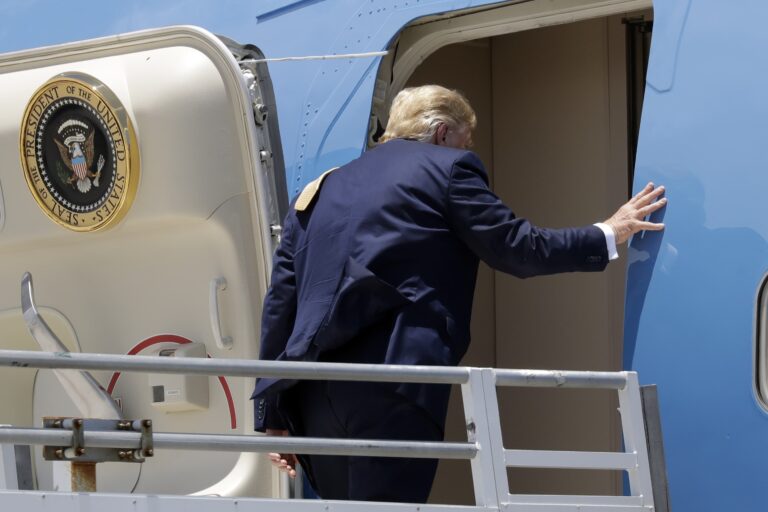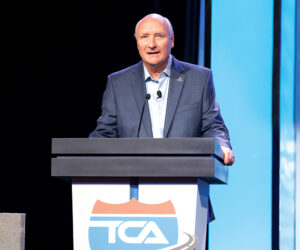 When President Donald Trump goes on a road trip (other than to play golf on a Sunday when he ought to be in church), he leisurely strolls out of the White House (probably wearing a red tie), throws a few nuggets to a press corps intent for the most part on hearing something that will make their report the top story on the evening news or the lead story in tomorrow’s print editions (at least where they still exist), navigates the freshly cut lawn and climbs aboard Marine One for a quick trip to Joint Base Andrews where he climbs the stairs to Air Force One waiting for the door to close and then for a takeoff down a silk smooth runway.
When President Donald Trump goes on a road trip (other than to play golf on a Sunday when he ought to be in church), he leisurely strolls out of the White House (probably wearing a red tie), throws a few nuggets to a press corps intent for the most part on hearing something that will make their report the top story on the evening news or the lead story in tomorrow’s print editions (at least where they still exist), navigates the freshly cut lawn and climbs aboard Marine One for a quick trip to Joint Base Andrews where he climbs the stairs to Air Force One waiting for the door to close and then for a takeoff down a silk smooth runway.
Contrast that to this.
We decide to take a 45-minute drive to Hot Springs, Arkansas, for a nice lunch at a restaurant that has outdoor seating on Lake Hamilton.
We head north on our subdivision (the street is nice and smooth because the subdivision is only a year or so old), turn onto Denny Road, where we dodge potholes for a mile or so (hoping no one is in the other lane), then eventually make a right on Kanis Road as we head toward Interstate 430, which will take us to Interstate 30, which will take us to U.S. Highway 270, which will take us into Hot Springs.
Just before we leave Kanis Road, we are subjected to a section of road that has to be the roughest in the U.S.
I-430 and I-30 through Benton are nice, but just on the other side of Benton we hit a stretch of I-30 where the right lanes have been beaten down by big rigs to the point that now even they cheat and move to the left lane.
Meanwhile, when he gets back in Washington, the it’s time for the president to meet with Congressional Democrats to further talk about a $2.2 trillion infrastructure package they so smilingly agreed to a couple of weeks ago.
The president is back from a smooth landing at JBA and the Democrats have ridden down Pennsylvania Avenue, which I’ll guarantee you has no bumps or bruises or potholes.
Once inside, Speaker of the House Nancy Pelosi accused Mr. Trump of a coverup (who in Washington hasn’t covered something up, except maybe Jimmy Carter?) and Mr. Trump turned, took his bat and ball and went out into the Rose Garden to tell the press what happened.
How childish.
After the so-called meeting, Pelosi said she intended to pray for Mr. Trump following that surprise Rose Garden news conference where he demanded Democrats quit investigating him (how childish of them).
A lot of folks better pray for Mr. Trump, Pelosi and everyone in Washington who has anything to do with this partisan politics game that is preventing us from getting the roads and bridges that the general public richly deserves after sending their “offering” to Washington every paycheck.
It’s time for Washington to get down on its knees and then get up and do something about our infrastructure.
* * *
If you don’t think things are bad, consider the fact that the length of America’s structurally deficient bridges, if placed end-to-end, would span nearly 1,100 miles, the distance between Chicago and Houston, a new examination of federal government data shows. And it’s a problem that hits close to home.
The American Road & Transportation Builders Association (ARTBA) analysis of the recently-released U.S. Department of Transportation 2018 National Bridge Inventory (NBI) database reveals 47,052 bridges are classified as structurally deficient and in poor condition.
Cars, trucks and school buses cross these compromised structures 178 million times every day, the data show.
Nearly 1,775 are on the Interstate Highway System.
The most traveled structurally deficient bridges are on parts of Route 101, Interstate 405 and Interstate 5 in California, where daily crossings are as high as 289,000 vehicles per day.
Although the number of structurally deficient bridges is down slightly compared to 2017, the pace of improvement has slowed to the lowest point since ARTBA began compiling this report five years ago.
States with the largest number of structurally deficient bridges are Iowa (4,675 bridges); Pennsylvania (3,770); Oklahoma (2,540); Illinois (2,273); Missouri (2,116); North Carolina (1,871); California (1,812); New York (1,757); Louisiana (1,678); and Mississippi (1,603).
Those with the most structurally deficient bridges as a percent of their total bridge inventory are Rhode Island (23 percent); West Virginia (19.8 percent); Iowa (19.3 percent); South Dakota (16.7 percent); Pennsylvania (16.5 percent); Maine (13.1 percent); Louisiana (13 percent), Puerto Rico (11.7 percent), Oklahoma (10.9 percent) and North Dakota (10.7 percent).
Remember those numbers next time you cross a bridge.
Lyndon Finney’s publishing career spans over 55 years beginning with a reporter position with the Southwest Times Record in Fort Smith, Arkansas, in 1965. Since then he’s been a newspaper editor at the Southwest Times Record, served five years as assistant managing editor of the Arkansas Democrat-Gazette in Little Rock and from November 2004 through December 2019 served as editor of The Trucker. Between newspaper jobs he spent 14 years as director of communications at Baptist Health, Arkansas’ largest healthcare system. In addition to his publishing career he served for 46 years as organist at Little Rock’s largest Baptist church.








